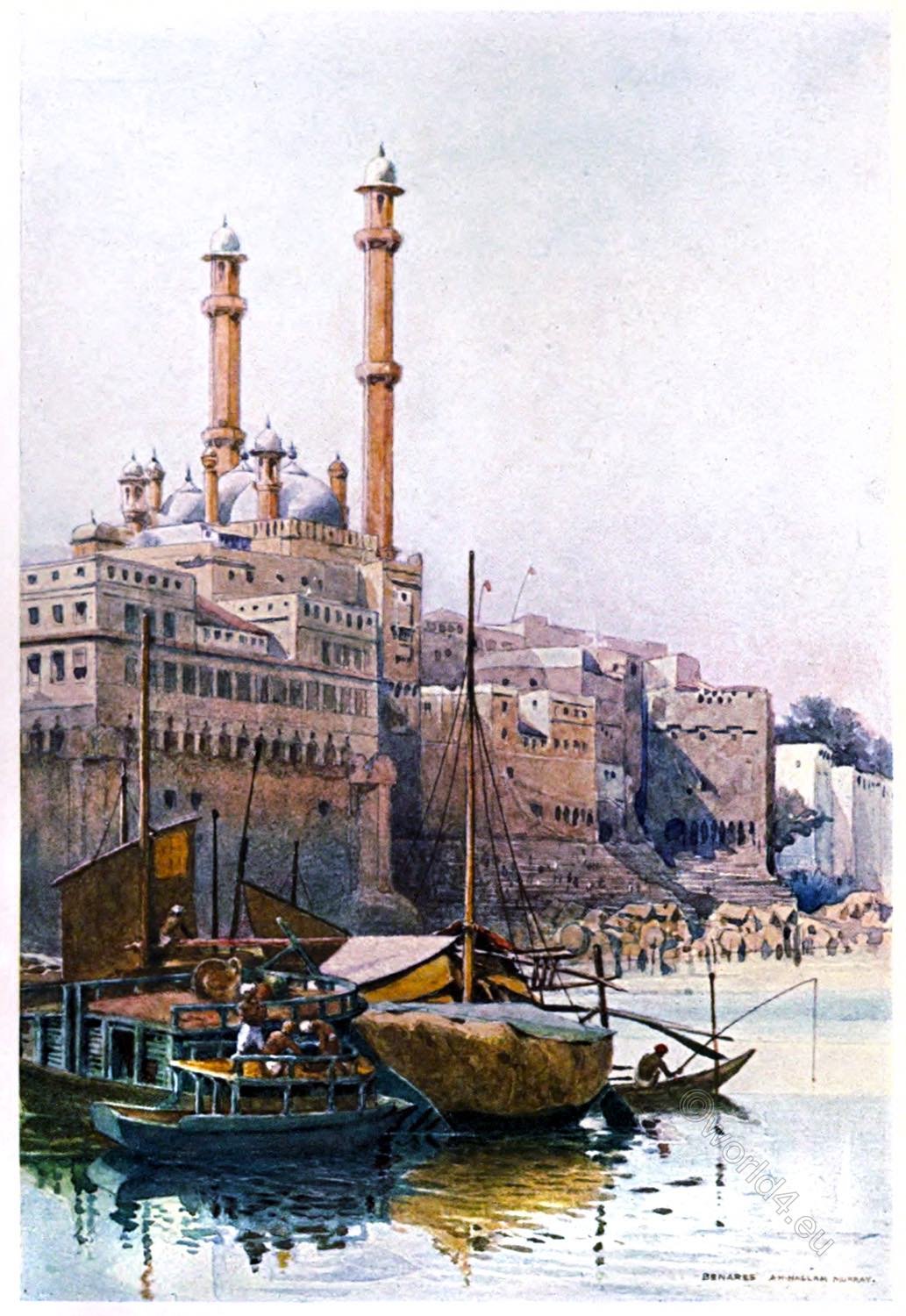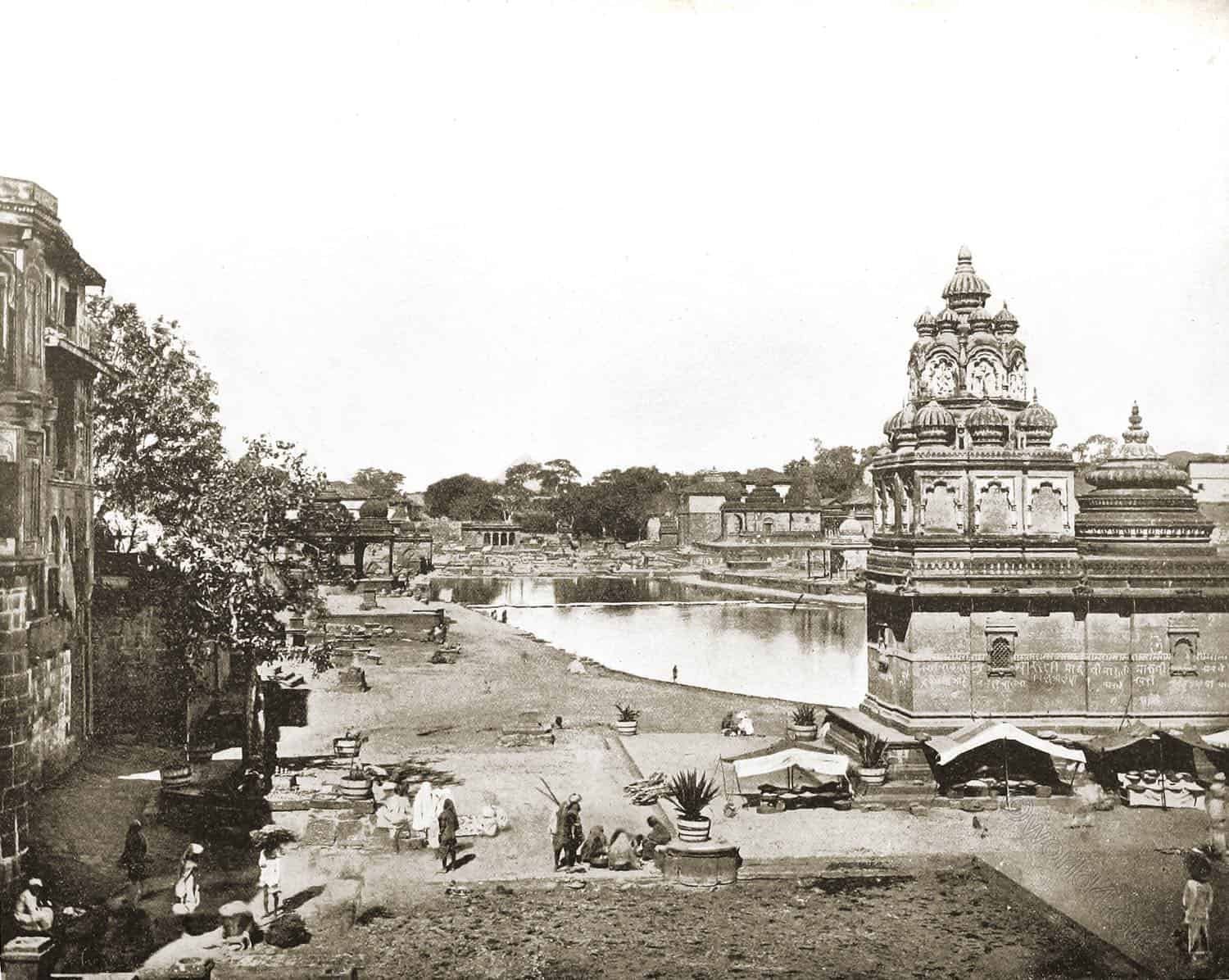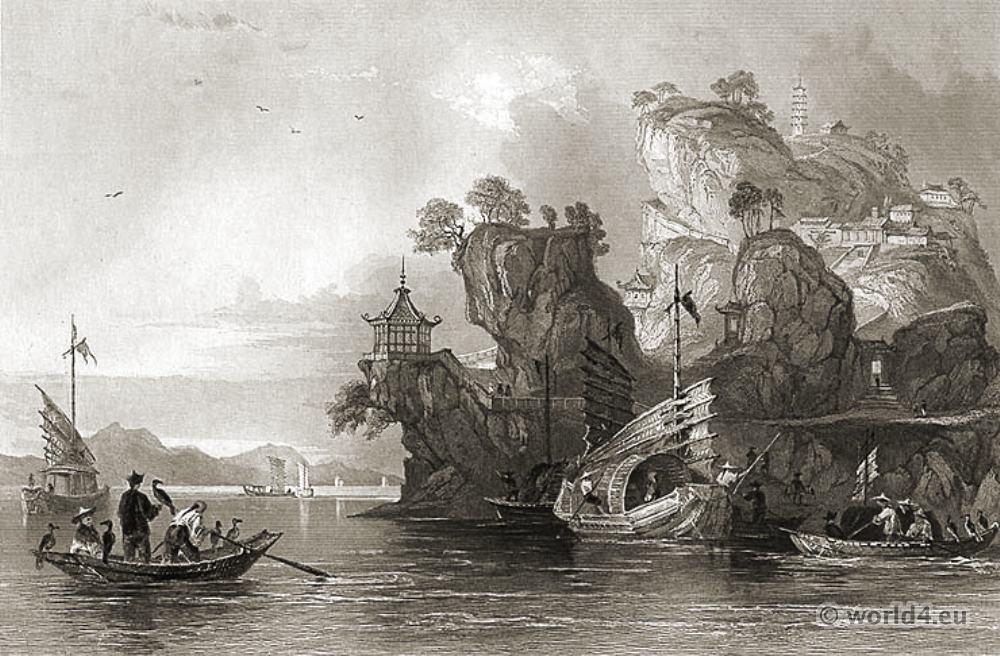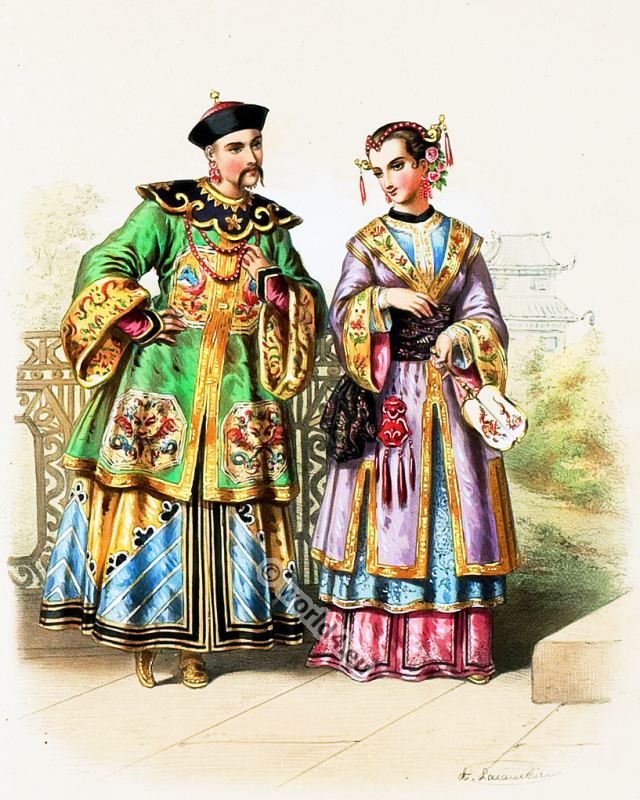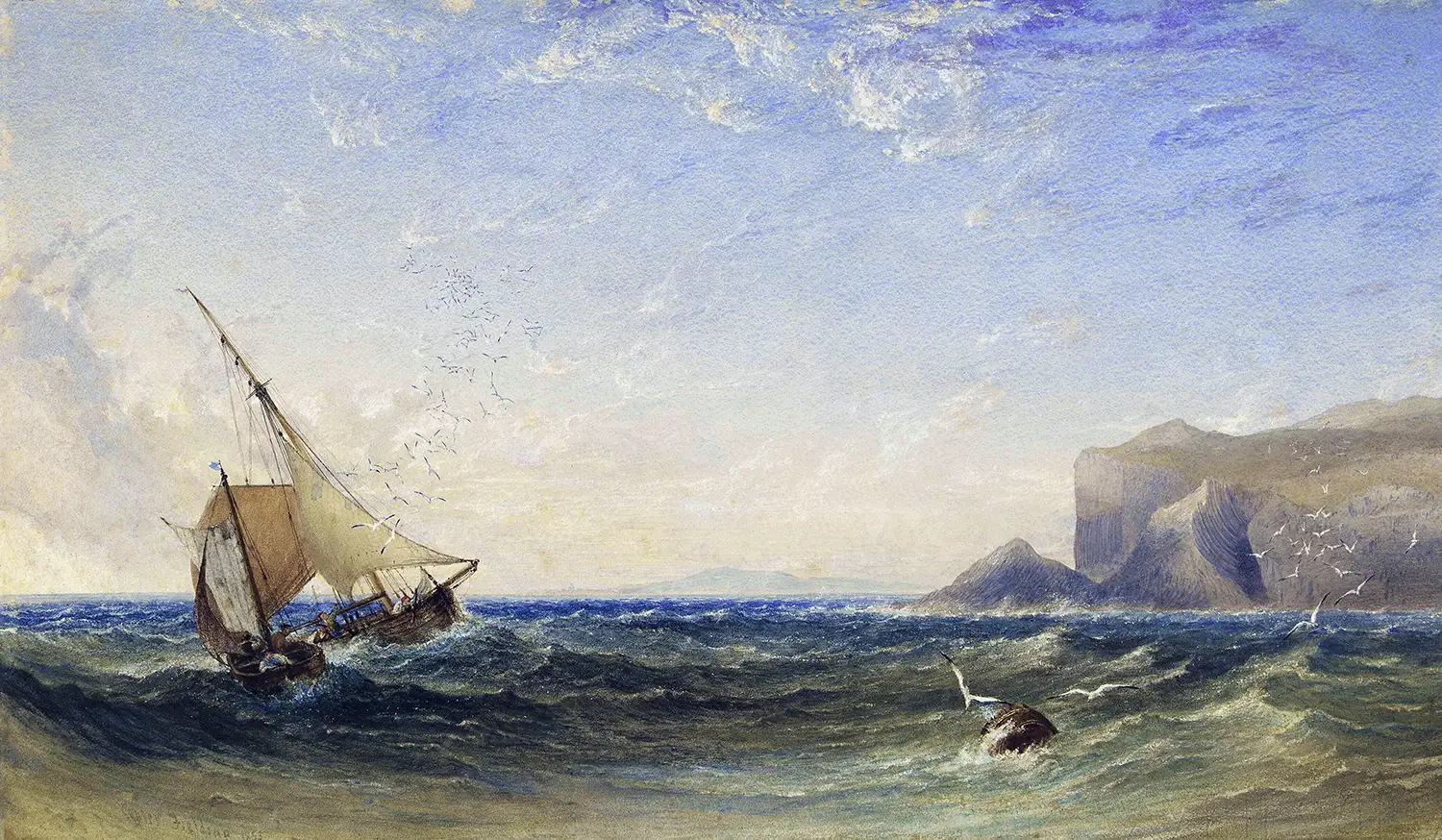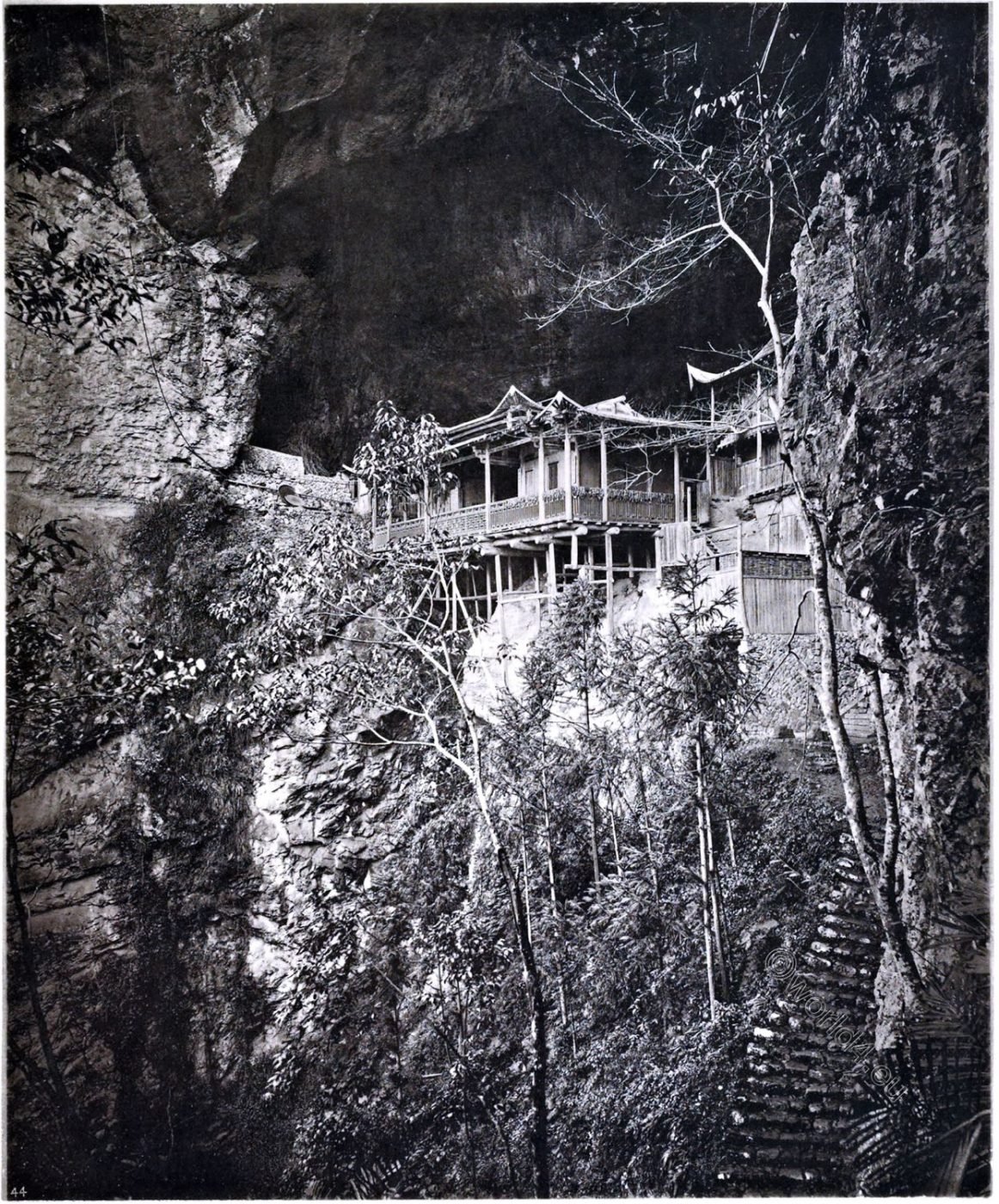
The Ssŭ Ta Ming Shan – “The Four Famous Hills.”
CHINESE CIVILIZATION.
By a man without passions I mean one who does not permit good and evil to disturb his internal economy, but rather falls in with whatever happens, as a matter of course, and does not add to the sum of his mortality.
Chuang Tau.
IT was lately remarked by a writer on China that the charm of this country, for the jaded visitor from the West, largely consists in the impression which it gives him that he has been carried magically backwards into the European Middle Ages. If this be China’s principal title to the homage of mankind, she seems to be reconciling herself with a light heart to its speedy forfeiture.
Already “Old China” is retreating to various remote fastnesses far off the beaten tracks of commerce and travel; while that section of young China which is at present in somewhat bewildered and precarious possession of the country’s strategic centers seems to be fully determined of one thing only-that whatever other faults may disfigure its future proceedings, medievalism shall not be one of them.
It may be doubted, after all, whether there was more than a superficial resemblance between the China of pre-reform days and the Europe of the Middle Ages. The civilizations of East and West had developed on different lines, and social conditions were in many important respects profoundly dissimilar. On the whole, there is strong reason to believe that until the inauguration of the modern scientific and industrial era in Europe, the civilization, culture, and wealth of China were on a higher and grander scale than anything that the West could show; but the difference was in kind as well as in degree.

Such is the impression we gain from a perusal of the chronicles of Marco Polo and other early travelers, and even from the works of some of the pioneer Catholic missionaries, most of whom express admiration as well as wonder at the outstanding features of Chinese civilization, with the necessary exception of the deplorable errors of the people in the matter of religious belief.
The traveller who finds much to charm him in what he regards as the medievalism of China is perhaps only giving unconscious testimony to feelings common to many a harassed victim of “the weariness, the fever, and the fret” which are, unfortunately, part of the price payable for the material advantages of twentieth-century civilization. “The heir of all the ages” sometimes gets a little weary under the load of his birthright, and if a kind destiny guides his pilgrim steps to the Far East, he is perhaps sometimes tempted to ask whether it is true, after all, that fifty years of Europe are in all respects to be preferred to a cycle of Cathay.
But such questions as these will soon be asked no more. The Cathay which the English poet had in his mind is already rivaling the West in its headlong haste and desire for change. The time is not far off’ when China’s foreign guest will point to this or that quaint feature of the national life and exclaim with enthusiasm:
“What a picturesque relic is this of the grave and courteous China of the good old days!” Will his Chinese host receive this remark with anything but chilling disapproval? “The object of your misdirected admiration,” he may observe, “is indeed a hideous survival from that grotesque and barbarous age which was happily brought to a close by our glorious Revolution.”

It would be difficult to specify which of the characteristics of Old China is likely to be so tenacious of life as to be still in a position, a century hence, to excite either sympathetic interest or disdainful censure. It is a matter of common observation, however, that religious observances and superstitions, all the world over, possess a wonderful vitality which enables them, under the protection of various disguises, to carryon a more or less maimed existence for ages after they have been formally discarded.

This being so, it is fairly safe to prophesy that the old customs and institutions of the Chinese which will survive the longest will be those which possess some religious significance. Among such customs is one which is of interest as forming a link not only with the China of very remote age, but also with the Europe of the Dark and Middle Ages, and even with the Roman Catholic countries of to-day.
PILGRIMAGES IN CHRISTENDOM
I will go down to self-annihilation and eternal death,
Blake, “Milton.”
Lest the Last Judgment come and find me unannihilate,
And I be seized and giv’n into the hands of my own Selfhood.
The cult of saints and martyrs in the West is paralleled by the cult of canonized heroes, bodhisattvas, and incarnate divinities in the East. In nearly all lands which have reached a moderately high level of religious development we find that a favorite mode of imploring the favor of spiritual beings or of paying reverence to the popular ideals of virtue and holiness has been to lay offerings of prayer or sacrifice before the images or sepulchers of the sanctified dead. Thus the performance of pilgrimages is a practice which is associated with the religious history of nearly every civilized or semicivilized country of which we have authentic record.
Perhaps it might surprise some of the devout Catholic pilgrims of to-day, and still more those of a few centuries ago, if they were told that in journeying to their favorite shrine of Sainte-Anne-d’Auray, or St James of Compostela, to the Holy House at Loretto in Ancona, to the apostolic tombs at Rome, to the grave of St Martin of Tours, to Cruach Phádraig (Croagh Patrick) in the west of Ireland, to La Salette in Dauphine, or to the grotto of Our Lady of Lourdes, they were obeying the same imperious religious instinct as that which sent the ancient Egyptians to the shrines of Sekhmet at Bubastis, Isis at Busiris, Apis at Memphis, and Ammon at Thebes.
Greece, we know, had her pilgrimages to the temples of Apollo at Delphi and Zeus at Dodona; and, indeed, the famous periodical gatherings at the Olympic, Pythian, Nemean and Isthmian games are believed to have been, in origin, gatherings of religious pilgrims. There was an annual Semitic pilgrimage to the temple of Ashtoreth at Hierapolis. Rome, too, had its pilgrimages in Pagan times as well as in Christian. Even in the so-called New World the invaders from Europe found that pilgrimages took place to the shrine of Quetzalcoatl in Mexico and to that of the Sun at Cuzco in Peru.
The pilgrimage to Mecca, as everyone knows, is a religious duty incumbent upon all true Mohammedans; but Mecca (which, indeed, was a holy place before the rise of Mohammedanism) is not unique in Islam, for pilgrims also go in their thousands to worship at Meshhed ‘Ali in Nejef and at the tomb of the Prophet at Medina. The Bahaist has already commenced to make pilgrimages to ‘Akka and Tabriz, though his religion only sprang into existence in the nineteenth century.
In India, the classic land of pilgrimages, nearly every racial and social group has sacred places of its own. The list of Hindu pilgrimages alone, in that nursery of religions, is far from exhausted when we have taken note of the Panch-kosi and the five ghats of Benares, the temple of Vishnu at Badarinath (Hindi: बद्रीनाथ मंदिर), and the much – maligned shrine of Jagannatha (Juggernaut) in Orissa 1). Even enlightened and modernized Japan still annually sends forth untold numbers of pilgrims to the shrines of Ise-jingū, to the reputed grave of Jimmu Tenno, to the deified peaks of Fuji and Ontake, and to that holy hill of Koya (Kōya-san), near Nara, which enshrines the relics of the revered Buddhist saint Kobo.
1) It has been proved that there is no truth in the hideous stories of the mangling of pilgrims under the “Car of Juggernaut.”
China, then, is not alone in being a land in which pilgrimages have flourished in the past and continue to enjoy a great if gradually diminishing popularity to-day. But pilgrimages in China possess certain features of their own which make them well worthy of special study, and certainly no student of Chinese life can hope to arrive at a sympathetic understanding of existing religious conditions in China unless he is prepared to become – if only imaginatively – a member of one of those merit – making (and merry – making) bands of pilgrims who annually traverse the plains of China on their way to the Sacred Hills and the wonder-working shrines of pusas and “immortals.”
Profound, O Vaccha, is this doctrine, recondite, and difficult of comprehension,
‘Majjhima Nikaya,’ “Sutta 72.”
good, excellent, and not to be reached by mere reasoning, subtile,
and intelligible only to the wise; and it is a hard doctrine for you to learn,
who belong to another sect, to another faith, to another persuasion, to
another discipline, and sit at the feet of another teacher.
When the Reformers in sixteenth century Europe condemned the cult of saints as superstitious or idolatrous, pilgrimages naturally fell into disrepute among the peoples that accepted Protestant principles, and it is now only the Catholic countries in which we may still witness scenes comparable with the religious pilgrimages of Eastern lands. It is a curious fact that though the Puritan – Protestants discouraged pilgrimages on principle, it was none the less a brave little band of Puritans that made the most momentous of all pilgrimages recorded in history. But it was not to visit an old shrine that the Pilgrim Fathers crossed the wide Atlantic: it was to found a new one.
In the far-off “ages of faith” the pilgrims of Europe were of many classes. Conspicuous among them was the sandaled palmer, whom most of us now regard only through the filmy haze of romance. We think of him, perhaps, as a travel-worn wanderer who appeared from time to time before the raised drawbridge of some moated castle, bringing tidings to its lonely lady of her lord’s heroic deeds and piteous death upon the crimson plains of Palestine.
The crusaders themselves, indeed, were pilgrims as well as soldiers. Perhaps this type of pilgrim was inclined to be more truculent and masterful than the patient disciple of Christ should be; but such characteristics were hardly to be wondered at in men whose lot was cast in a bellicose world, and in whom religious devotion was tempered by martial ambition.
We of British race have had palm-bearing wanderers among our ancestors, and sword-bearing crusaders too, as many coats-armorial in our village-churches and manor-houses still remain to testify. But if pilgrimages to the Holy Sepulchre in Jerusalem, whether warlike or peaceful, were beyond either the hope or the ambition of the masses of our people, there were always multitudes of pilgrimages in which even the poor could take part without having to leave their native shores.
Pilgrim shrines existed in large numbers all over England and southern Scotland: no fewer than thirty-eight of them were to be found in a single English shire. 1) That Englishmen entered upon such pilgrimages with all the zest of their fellow Christians on the Continent there is no reason to doubt; and the fact that such undertakings were a source of delight (not always of an exclusively spiritual kind) to those who took part in them will not be disputed by any one who has imbibed the spirit of the Canterbury Tales.
1) This was Norfolk. See Sidney Heath’s Pilgrim Life in the Middle Ages.

The main source of the popularity and vitality of ordinary religious pilgrimages in all parts of the world seems to be this, -that they are among the few mundane activities in which keen physical and mental enjoyment may coexist with an exhilarating sense of religious fulfillment. Very early in life we all make the rather dismal discovery that duty does not always coincide with pleasure, and that the things which are alleged to be good for us are seldom the things we like best. But he who assumes the script and staff of the conscientious pilgrim has no qualms about any possible conflict between the pleasant and the good. Provided only that he possesses enough worldliness to make him heartily responsive to beautiful sights and sounds and the joys that accompany a relaxation from the routine of daily toil or business, and enough spirituality to make him appreciative of the religious significance of his pilgrimage, he will find himself in the fortunate position of being able to gratify soul, mind, and body all at the same time.
Travel has been aptly described as “a perfect epitome of life,” because it presents to us an infinite fluidity of circumstances and demands from us an equal flexibility of character. 1) If applicable to travel in general, these words are pre-eminently true of the religious pilgrimage.
1) See The Spectator (13th July 1912).
No doubt there were many abuses connected with pilgrimages, abuses which in Christendom sometimes assumed so serious a character that princes and bishops were occasionally obliged, in the interests of public and private morality, to recommend the intending pilgrim to stay at home and to “expend the sum thou hast gathered for the journey on the support of the poor.” Even saints (unconscious, perhaps, of the reverence with which their own mortal remains might be regarded by the pilgrims of a later age) have been known to express disapproval of pilgrimages. One of these was St Gregory of Nyssa, who in the fourth century wrote a letter de euntibus Hierosolyma, in which he expressed himself on the subject with no uncertain voice.
But, alas, how hard it is for the Will to sink into nothing, to attract nothing, to imagine nothing.
Behmen, “Dialogues.”
Let it be granted that it is so. Is it not surely worth thy while, and all that thou canst ever do ?
In both East and West, moreover, there have been cases in which pilgrimages of a painful and excessively arduous kind were undertaken in consequence of a vow, or by way of penance, or in accordance with the gloomy tenets of a semi-savage code of religious ethics. Thus in both Europe and Asia we hear of self-inflicted agonies caused by spiked shirts, iron chains and girdles, terrible lacerations of the body, deliberate self-torture of almost every imaginable kind.
In many well-authenticated cases in the East we read of pilgrimages that ended in the willful self destruction of hapless and ignorant pilgrim devotees. There are she-shen-yai, or Suicide Cliffs, at the summits of some of the holy mountains of China; and the name given to these precipices is significant, not of a grotesque fancy in nomenclature, but of a grim tragical reality. Yet there is nothing in the theory of pilgrimages to countenance a loose morality or a morbid fanaticism. Manifestations of religious frenzy are not peculiar to pilgrims. Far oftener, indeed, they accompany the psychological eccentricities of the solitary mystic and the cave-dwelling hermit-just as it is these, too, who have been most fiercely assailed by the devils of human passion.
From many points of view the Protestant reformers of Christendom did right in suppressing pilgrimages in north-western Europe. Yet it must be admitted that the change involved losses as well as gains. Moreover, in this as in many other matters, the zeal of the reformers led them into the delusion that human nature was soft clay, and that they alone were the potters who had the power and the right to mould it into new shapes.
Pilgrimages might be suppressed, but the pilgrim instinct, if we may call it so, survives to this day, though it has become secular rather than religious in its aims, and tends to identify itself in many cases with the “globe-trotting” instinct. It is perhaps the Positivists, in their reverent visits to the places associated with the lives of the” saints of humanity” (as distinct from the saints of the Catholic Church), who are the best representatives of the pilgrims of medieval Europe. Most of us, indeed, are pilgrims still, though instead of seeking the tomb of a saint we now direct our pilgrim-steps towards shrines of another kind-the most popular of all, it is to be feared, being the shrine that is consecrated to that nomen daemonic-mammon.
In Chaucer’s age the most popular months for pilgrimages were April and May the period of the year that has been always greeted with exuberant delight by the poets of England. “Then longen folk to goon on pilgrimages “- not necessarily, indeed, because the lamp of piety then burned more brightly in their souls than at other times, though doubtless this was often the case too, but rather because, as our poet so well divined, Nature then “pricked their hearts” with a longing for the open air and all the sweetness of an English spring; because April with its fragrant showers, and the west wind with its warm breath, had driven away the last signs of the torpor and gloom of an English winter; because “tender fowles maken melodye” to welcome the birth of summer, and had a glad song for the welcoming of man, too, if only man would come out under the blue sky to hear it.
In the Far East, as in fourteenth – century England, there are “pilgrim-seasons.” In Japan the blossoming of the plum and cherry in spring and the tinting of the maple-leaf in autumn are signals that send young and old out to the hills and woodlands, and it is at these seasons that the roads to the popular shrines of Shinto and Buddhism are worn smooth by pilgrim-feet.
PILGRIMAGES AND THE SACRED HILLS OF BUDDHISM.
By a man without passions I mean one who does not permit good and evil to disturb his internal economy, but rather falls in with whatever happens, as a matter of course, and does not add to the sum of his mortality.
Chuang Tau.
In China, where the diversities of climate are greater, and the competing shrines far more numerous and widely-scattered, the seasons for pilgrimages vary with local climatic conditions. It is fitting that the sacred peaks of the lofty mountains of north and west should be the pilgrim’s goal during the scorching summer, and that the shrines and temples in the tropical and sub-tropical southern provinces should receive their meed of homage during the winter.
No attempt can be made in these pages to enumerate and describe all the great pilgrim-centers of China, for we should have to deal with the sacred places not of one religion only, but of three. The places of pilgrimage recognized by the devotees of the heterogeneous system of Taoism are so numerous that a mere catalogue of them would fill several pages.
Conspicuous among them are the Wu Yo, or Five Sacred Hills, the sanctity of which is indeed of pre-Taoist date but has come to be associated with Taoist developments. Of Confucianists, as such, it can hardly be said that they are in the habit of traveling in the guise of religious pilgrims, because the cult of the canonized Confucius, as distinct from Confucianism as a rule of life and code of moral law, is not a cult which requires or expects the religious co-operation of the masses of the people.
The Confucian worship is (or was) a part of the State ritual, and was conducted by the emperor and his delegates in their official or priestly capacity. Yet there are certain holy places in China which, as a matter of fact, are visited by thousands of professing Confucianists every year, and which will doubtless continue to be visited by Chinese and foreigners of every creed long after the Confucian system has ceased to occupy in China a position of semi-religious pre-eminence. The most important of these places are to be found within a radius of a few miles, in a south-western corner of the province of Shantung.
You cannot step twice into the same waters, for fresh waters are ever flowing in upon you.
Herakhitus.
They consist of the grave of the famous Duke of Chou (Dan, Duke Wen of Zhou 11th Century BC), whose saintliness was such as to haunt Confucius according to a well-known anecdote-even in his dreams; the temple and tomb of Mencius, and the grave of Mencius’s mother-the Chinese model of what a good mother should be; the splendid temple to Confucius himself, within the walls of his own venerable city of Ch’ü-fou (Shantung), which to this day is chiefly populated by men of his own clan and surname, and within which resides the ducal representative of the seventy – sixth generation of his direct descendants; and, lastly, the great sage’s own grave, situated in one of the most beautiful and impressive cemeteries in the world. In addition to the sacred places of Taoism and Confucianism, China possesses innumerable shrines of Buddhism, and it is with these, or rather with a few of the most famous and important of them, that we shall be mainly occupied in the later chapters of this book.
There are various theories held by the Chinese as to the date at which Buddhism entered their country. The truth of the” matter probably is that it had to be introduced on several different occasions before it succeeded in gaining a firm foothold. As we have seen, there is some reason to believe that the religion first reached China in the third century B.C., possibly as a result of the missions sent out from India by Asoka, but that it speedily disappeared under the discouraging influence of the book-burning and wall-building emperor Ch’in Shih-huang (Qin Shi Huang Di, 秦始皇帝, Pinyin Qín Shǐhuángdì, first Ch’in (Qin) Dynasty emperor).
The next attempt of Buddhism to enter China seems to have taken place in the year 2 B.C. In that year a Chinese embassy was sent to the Yüeh-chih (Yuezhi), or Indo-Scythians. The king of the Yüeh-chih, whose Buddhism must have been of a heterogeneous type, is said to have ordered his son, the prince-royal, to instruct the Chinese envoys in the Buddhist scriptures, in order that on their return to China these envoys might act as missionaries of the “true religion.” But Chinese Buddhists do not attach much importance to these stories.
According to the popular account, the beginnings of the continuous history of Buddhism in China are associated with the reign of the Emperor Ming Ti, who, having been visited in a vision or dream by a “Man of gold,” sent envoys to Central Asia in the sixty-sixth year of our era to look for him. This resulted in the arrival of two Buddhist missionaries – Kasyapa-Matanga (Jia Yemoteng 迦葉摩騰) and Gobharana (in Chinese, Mo-t-eng and Chu Fa-lan) – who were accommodated at the capital in a building which subsequently became famous as the Monastery of the White Horse.
Although these monks or missionaries made a modest beginning of the prodigious task of translating the Buddhist scriptures into the Chinese language, it is not to be supposed that the progress of the religion was uninterrupted from that time forward. It was not till about the fourth century of our era that Buddhism began to emerge from obscurity and to occupy a conspicuous place in the religious life of the Chinese people.
Confucianism has always been more or less hostile to, or severely critical of, the whole Buddhist system; more especially has it been the declared enemy of the Buddhistic institution of monasticism, which with a good deal of reason it regards as inconsistent with a sound social ethic. Most of the persecutions undergone by Buddhism, therefore, have been initiated by Confucian statecraft.’ But there is reason to believe that the first enemies against whom Buddhism had to strive in China were not Confucians, but the priests of Taoism, who, as the generally recognized guardians of occult secrets, and as adepts in demonology and sorcery, were jealous of the appearance of a foreign doctrine which would or might prove a dangerous rival.
The contests between Buddhism and Taoism are commemorated in stories which often remind us of the legends relating to the early struggles in Europe between paganism and Christianity. The two Eastern religions seem to have competed for the royal favor in China just as St Patrick (to take one example) is said to have competed with the Druids in Ireland for the favor of King Loigaire, each of the contesting parties striving to vanquish its rival by giving evidence of a superior skill in the working of miracles.
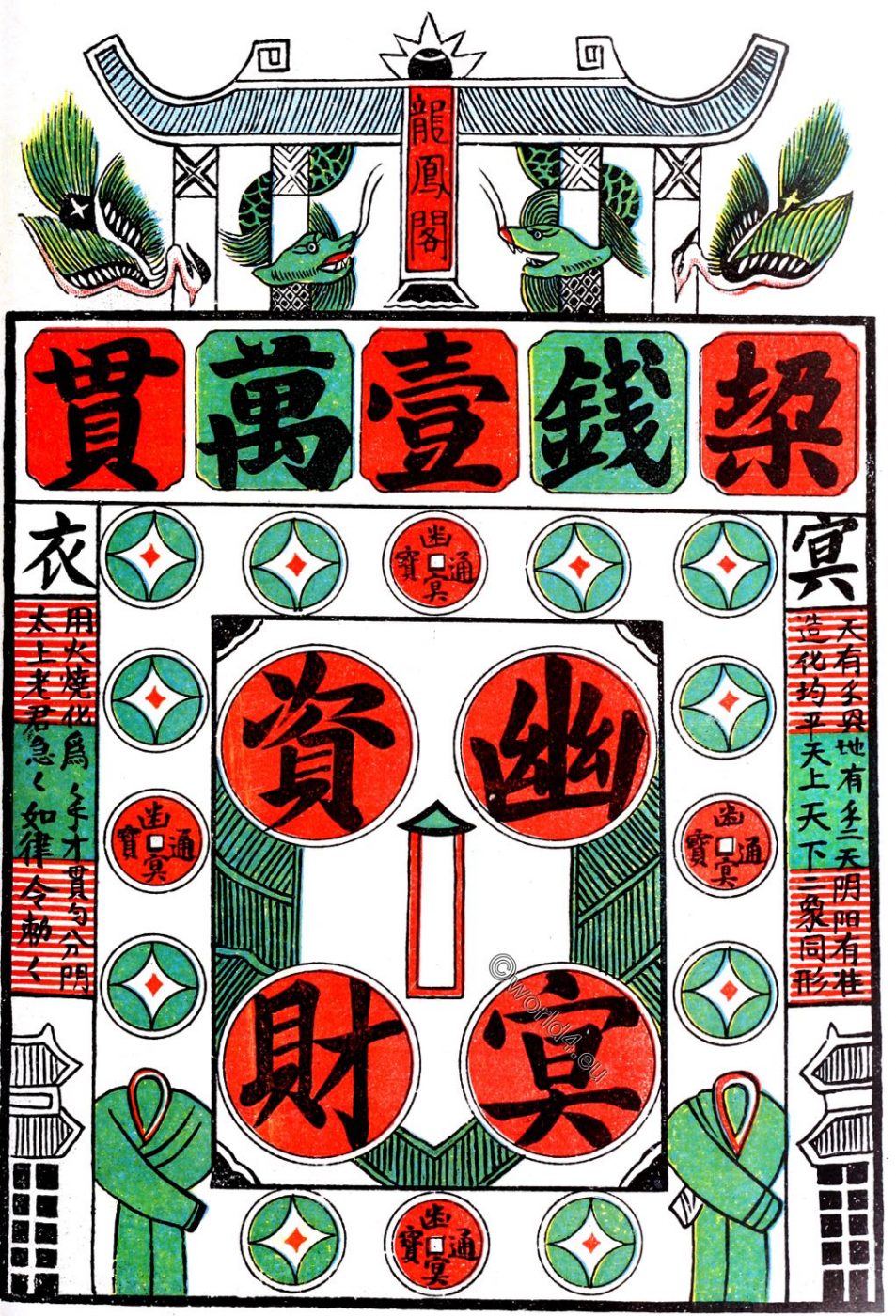
A well known Buddhist legend tells us how certain priests of the Five Sacred Hills submitted a memorial to the throne shortly after the arrival of Mo-t’eng and Chu Fa-Ian in the first century of our era. In this memorial the Taoist priests recorded their solemn protest against the friendly attitude assumed by the emperor towards the religion of the “Western barbarians” and reproached him for his neglect of the native wisdom of China. We are willing, they said, that our teachings and those of the Buddhists should be put to the proof. Take the books of the Buddhists and our own holy writings and set them afire. If theirs are consumed, let the barbarians be banished; if ours are burned, we are prepared to suffer death.
This suggestion seems to have appealed to the emperor’s sense of justice. Elaborate preparations were made for a public competition in wizardry between the rival priesthoods, and for testing the truth or falsity of their respective teachings by submitting their sacred books to the ordeal of fire. The Taoist priests, we are told, were ordinarily in possession of various supernormal or spiritualistic faculties which gave them control over the forces of nature and enabled them to ride through the air on dragons made of straw. They arrived on the scene of the competition full of confidence in themselves and full of contempt for their Buddhist rivals; but when the time came for a public demonstration of their skill they were horrified to find that all their magical powers had mysteriously deserted them. Complete failure attended all their efforts to produce what modern spiritists would term “phenomena”; and no sooner were their holy writings placed on the pyre than the flames attacked them with irreverent fury.
One book only was saved: this was the Tao-te-ching (Daodejing), which was snatched from the fire by one of the priests. The turn of the Buddhists came next. Without hesitation they took their images of Buddha and their volumes of sutras and thrust them into the midst of the flames. There, in full view of the emperor and his court, they remained absolutely uninjured, for the flames were miraculously transformed into petals of waterlilies, by which all the books and images were enfolded and supported. The chronicler concludes by telling us that of the vanquished and discredited Taoists some committed suicide by hanging and drowning themselves, while others shaved their heads – which means that they entered the Buddhist monk hood. 1)
It is needless to speculate as to whether there is any basis of fact in this story. Its chief interest for us lies in its reference to the position of the Taoists as priests of the Five Sacred Hills. Mountain-worship, indeed, had existed in China many centuries – possibly thousands of years – before Taoism came into existence, or at least before it had evolved itself out of its primeval nebula.
1) Another account says that the Taoists fell dead in the presence of the assembled company. There are several versions of the story of the contest between the Taoists and Buddhists. ‘That followed in the text is taken from a commentator’s notes to a Ming dynasty edition of The Sutra of Forty-two Sections-the work which was translated by the pioneer-missionaries Mo-t’eng and Chu Fa-lan (B.N. 678, Har. xxiv, vol. v. pp. 1-2; see also B.N. 1471, 1472).
From one of the first pages of Chinese history, dealing with events ascribed to the third millennium B.C., we learn how the Emperor Shun made a solemn pilgrimage to the sacred hills of the four quarters, of his empire; and it is clearly implied that in doing this he was carrying out state-ceremonies which were part of the religious inheritance of his race.

The Taoists were the first to associate themselves and their traditions with the Wu Yo, or Five Sacred Hills, but the Buddhists were not disposed to allow their rivals to monopolize mountains in general. Buddhism had itself originated in a land where mountain-worship was deeply-rooted, and it has always tended directly or indirectly to foster in its adherents a strong love of wild nature. It was not through mere imitation of Taoism that the Buddhists began to establish themselves on mountain – heights, but rather in obedience to a strong instinct to place the sanctuaries of Buddha high up amid the solitudes of crag and forest and lonely ravine, far out of reach of sights and sounds hurtful to the serenity of souls that had abjured the vanities of the world and the flesh.
Not I, not any one else can travel that road for you. You must travel it for yourself.
Walt Whitman.
Some of the hermitages which they built amid the romantic scenery of the most beautiful mountains in China grew into great and famous monasteries, and in the days when Buddhism in China was still in what may be called its constructive and productive period (which closed about a thousand years ago) such monasteries were thronged with learned scholars, translators, and religious philosophers. So long as Buddhism remained a power in India there was uninterrupted intercourse of a most friendly and inspiring kind between the great religious houses of the two countries. Chinese pilgrims spent years of their lives in visiting the holy land of their faith and in collecting and collating palm-leaf manuscripts of the sacred sutras. Natives of India, too, were in the habit of paying long visits to the seats of Buddhist learning in China, and many of these Indian pilgrims, having become honored residents in the great Chinese monasteries, collaborated with native monks in the arduous work of translation and exposition.
Among the great mountain strongholds of the Buddhist faith in China four emerged into a position of relative prominence, especially as objects of pilgrimage. These are known as the Ssŭ Ta Ming Shan – “The Four Famous Hills.” They are Wu-t’ai-shan (Wutaishan, Mount Qingliang) in the northern province of Shansi; Omei-shan in the western province of Ssŭch’uan (Sichuan); Chiu-Jiua-shan (Huà Shān, Jiuhua Shan, 華山 / 华山) in the central province of Anhui; and Puto-shan (Putuo Shan, 普陀山, Pinyin Pǔtuó Shān) off the east coast of the province of Chehkiang (Zhoushan, Zhejiang).
Of Omei-shan we shall have little to say in these pages, for it has already been fully described for English readers 1). The position of Wu-t’ai is somewhat exceptional, for this mountain has to a great extent become a seat of Mongol Lamaism. It is mainly to the shrines of the remaining two, Chiu-hua and Puto, that the reader’s attention will be directed in the following chapters.
1) See Little, Archibald John, Mount Omi and beyond a record of travel on the Thibetan border; the present writer, From Peking to Mandalay, and Miss E. Kendall, A Wayfarer in China.
At first sight it seems difficult to understand why the four mountains just named were singled out for exceptional distinction, especially when we remember that there were other groups of mountain – monasteries which were no less celebrated as centers of Buddhist light and learning. The abbots of the monasteries of the Four Famous Hills have no control, customary or statutory, over the abbots of other Buddhist establishments, nor does their position carry with it any dignity to which other abbots may not aspire. Only a restricted number of monasteries in China possess the right of granting ordination, but the monasteries of the Four Hills are not exclusively favored in this respect.
Some establishments, again, are distinguished as having been the centre of some important movement in Buddhist history, or as having sheltered a monk or group of monks who founded a new sect or school; but these are to be found on many mountains other than the privileged Four. Thus we are obliged to conclude that the rank or precedence accorded by common consent to the Famous Hills belongs to the mountains themselves, irrespective of the fame of the numerous religious houses perched on their slopes. Though the Buddhists did not require to go to the Taoists to be taught a love of mountains, it seems likely enough that it was in imitation of the Taoist or pre-Taoist classification of Four (afterwards Five) Sacred Mountains that the Buddhists resolved to create a kind of nobility or aristocratic pre-eminence for certain favorite mountains of their own.
The history of the Wu Yo goes back for thousands of years indeed four of the five peaks were regarded with religious veneration at a period anterior to the earliest days of which we have written record. The four famous hills of Buddhism can lay claim to no such antiquity. Two of the number-Wu-t’ai and Omei – are associated by history and legend with the beginnings of Buddhism in China; but the other two – Chiuhua and Puto – did not come into prominence until Buddhist prosperity in China had already reached and passed its climax. Of the sacred isle of Puto we hear little until we reach the closing years of the T’ang dynasty, and its Buddhist associations cannot be proved to be much more than a thousand years old. Chiu-hua has had a longer monastic history than Puto, but it was not included in the category of “Famous” Buddhist mountains until a date that was subsequent even to that of the inclusion of Puto.
The five elements
But the two questions are still unanswered as to why the Buddhistic writers of the Sung dynasty should have finally decided upon four as the proper number of “Famous Hills,” and why the four selected for elevation to this peerage of mountains should have been Wu-t’ai, Omei, Puto, and Chiu-hua. With regard to the first question, it seems clear that the number was chosen in order to establish what might be called four corner – stones of the Buddhist faith in China and to bring them into mystical association with the four cosmogonical “elements” which, according to the ancient Hindu philosophy adopted by Buddhism, are concerned in the alternating processes of construction and dissolution through which the whole phenomenal universe is continually passing. These four so called “elements” were wind or air, water, fire, and earth. 1) It is unnecessary here to go into the interesting question of the origin of the system of cosmogony of which this “great element” or Mahābhūta theory forms a part. Its antiquity is indicated by the fact that it was adopted, with or without modification, by some of the earliest Greek speculators in physics.
1 Fêng, Huo, Shui, Ti. According to another Chinese classification of the “elements” they were five in number, and consisted of metal, water, fire, vegetable matter, and earth (Chin, Shui, Huo, Mu, T’u). These are the Wu hsing, or “five elements,” mentioned in the Historical Classic (Shu Ching). They occupied a prominent place in the semi-mystical system of the Taoists of the Han dynasty, and were the subject of much theorizing on the part of the orthodox Chinese philosophy of the Sung period.
That the intention was to connect the Four Hills of Buddhism with the Four Elements is no mere guess; for it is explicitly stated by Chinese writers on the subject of these mountains that Wu-t’ai is associated with the element Air, Omei with Fire, Puto with Water, and Chiu-hua with Earth.
These pairs were not selected at random. W u-t’ai stands appropriately for the element Air, which in this connexion is represented in the Chinese language by a character commonly used to denote Wind. Omei is situated in the warm region of Southern Sechuan: what more fitting “element” could be chosen for it than Fire? Puto is entirely surrounded by the sea: it is obviously the region of the element Water. Chiu – hua is sacred to a Bodhisat or saint whose works of mercy are associated with the Buddhist “hells.” These regions are supposed by the ignorant to be situated somewhere under the earth, and are known to the Chinese by a word (ti-yu) which signifies “earth-prison.” It is clear that the element correctly associated with Chiu-hua must be ti-Earth.
As to the second question-why these hills, rather than any others, were honored with the distinctive epithet of “Famous” – it may be said at once that their mere altitude had very little to do with the matter. Wu-t’ai and Omei, indeed, are among the loftiest hills in China, if we rule out the vast ranges of the extreme west, which geographically belong to Tibet and Turkestan; but Chiu-hua is of no exceptional height, and Puto barely reaches even the modest elevation of a thousand feet. The matter was simply determined by a desire to place a physical pillar of Buddhism at each of the four points of the compass.
It is certain that the Wu Yo were chosen as sacred mountains on account of their positions in the north, south, east, west, and central regions of the China of classical or pre-classical antiquity. Similarly, it was considered fitting that the four mountain pillars of Buddhism should occupy positions which would justify their assuming the duties of wardens and protectors of religious interests in each of the four quarters of the empire. Wu-t’ai, therefore, was selected as the northern mountain, Omei as the western, Puto as the eastern, and Chiu-hua as the southern. It is true that Chiu-hua is in the centre rather than in the south of the China that we know to-day. It is to be remembered, however, that nearly all the territory on the right bank of the Yangtse lay to the south of the so-called “orthodox” states of the China of the Chou dynasty; and the pedantic spirit of literary and historical conservatism would prevent the Sung scholars from admitting that the southern expansion of China in the intervening centuries could render obsolete the geographical and political demarcations of the classical epoch.
Another reason, and a very important one, for the promotion of our four mountains to the exclusive rank of “Famous” was that all four had already become celebrated in Buddhistic lore through their legendary association with four of those great Bodhisats (or Pusas, to use the ordinary Chinese term 1) who play so important a part in the mythological and symbolic system of the Mahayana. The four Bodhisattva’s in question are Wen-shu (Manjushri), P’u-hsien (Samantabhadra), Ti-tsang (Kshitigarbha), and Kuan-yin (觀音 / 观音, Pinyin Guānyīn, W.-G. Kuan-yin); and these divine beings are the spiritual patrons of Wu-t’ai, Omei, Chiu-hua, and Puto respectively.
We have now seen that certain of the numerous hills sacred to Buddhism in China have been selected for promotion to a position of special honor. But there is another category of Buddhist mountains which is worthy of notice, if only because it includes the names of certain monastic centers which are also visited by multitudes of pilgrims, and which, on account of their historical and religious importance, would necessarily occupy a conspicuous place in any comprehensive account of Buddhism in China.
The mountains that come within this category are eight in number and are known as the Pa-hsiao-ming shan – “Eight Small Famous Hills” – to distinguish them from the pre-eminent Four. They are T’ient’ai, in Chehkiang; Yünt’ai and Tamao, in Kiangsu; Chitsu, in Yünnan; Wuchih, in Kuangtung (Hainan island); Ch’iyün, in Anhui, Wutang, in Hupei; and Wu-i (Bohea Hills), in Fuhkien. Some of these (Tamao and Wutang, for example) are celebrated in the annals of Taoism no less than in those of Buddhism. The most famous from the Buddhist point of view are Tient’ai, Wutang, and Wu-i; but all are annually visited by numerous bands of worshippers.
Among other holy mountains and monasteries which occupy a prominent place in the Buddhistic history of China may be mentioned Chiao-shan Chin-shan and Pao-hua, in Kiangsu; Lofou, in Kuangtang; Lu-shan, in Kiangsi; Yü-wang and T’ien-mu, in Chehkiang; Ku-shan in Fuhkien; Chung-nan, in Shensi; the Nan-Yo, in Hunan; Miao-fêng, Shang-fang, and other mountains, in Western Chihli; and the monasteries of Shaolin, on the Shao-shih mountain in Honan, Chao-ch’ing and others on the Western Lake near Hangchow, and Ling-yen, to the north-west of T’ai-shan, in Shantung.
When it is realized that the shan-chih, or mountain-chronicles of China, would alone constitute a library of thousands of volumes, it will be understood that the subject is not one that can receive exhaustive treatment in the narrow limits of a single book. In devoting special attention, in later chapters, to two of the Four Famous Hills, we shall be only touching the fringe of a subject which is well worthy of far closer attention than it has hitherto received from students of the religious and artistic sides of Chinese culture.
Source: Buddhist China by Reginald Fleming Johnston. London, J. Murray, 1913.
Discover more from World4 Costume Culture History
Subscribe to get the latest posts sent to your email.


